Talent management
Oct 9, 2024
Why do employees stay at your company
Introduction
Talent Management, embodied in attracting, retaining, and motivating superior employees is a critical issue as it is amongst the top concerns for modern corporations. The turbulent economic and social contexts push organizations to strive to be a talent magnet for the best employees in the labor market, and exacerbate the necessity of deploying effective strategies to motivate them. More specifically, the inevitable impact employees’ turnover rate has on the investment and cost-mitigation strategies, renders the issue of employees’ retention a top concern for all companies. This is even more relevant for local organizations that are more vulnerable to the economy’s conditions and complexities, along the competition they face from the more well established MNCs which are generally more attractive to employees, especially Gen Y workers.
In light of this, it is undoubtedly crucial for any corporation to understand and pinpoint all the factors that would contribute to its employees’ departure or retention. This, however, is not an easy job as it requires more than making assumptions. That is especially true given the complex characteristics of today’s workforce with their ever-increasing needs and expectations; whether in terms of their working environment, nature of work, management style, work-life balance, or personal and career development. The inter-dependability and multiplicity of these factors, therefore, necessitate organizations to take a systematic and an objective approach to identify, highlight, analyze, and understand these factors; and use such invaluable knowledge to inform and guide the strategy formulation and decision-making processes.
This report sheds the light on some of the findings of a Stay Survey that was conducted in one of the leading companies which has been operating in Egypt and the region for more than 10 years, with a workforce of more than 1000 employees. The survey was intended to gather a broad feedback about the reasons for which employees are staying within the corporation and use the findings to guide its employee retention strategies. The identity of the organization is kept anonymous in this report for the sake of confidentiality.
The first section of this report discusses the data findings, and the second section provides some recommendations and action-oriented suggestions.
Data Findings
This section highlights the insights excerpted from investigating the relationships between employees’ age, gender, and years of experience, on one hand, and reasons for staying, types of recognition favored, and preferred job aspects, on the other hand.
Reasons for Staying
Employees’ responses regarding the reasons for staying within the organization reveal that ‘Sense of Belonging in a Market Leader Company’ is the number one reason, followed by ‘People & Work Environment’ as the second reason. The third, fourth, and fifth reasons comprise ‘Skills Development & Growth’, ‘Professional Management Style & Recognition’, and ‘Compensation’ respectively.
More specifically, when looking at the relationship between employees’ age and reasons for staying, the same ranking of the five above-mentioned aspects is observed for the age groups (25 and below), (26 – 35), and (36 – 45) but with different percentages. The case is, however, different for the age group (46 and above), where ‘Skills Development and Growth’ comes in the second place, ‘Compensation’ in the third place, ‘Professional Management style & Recognition’ in the fourth place, and ‘People and Work Environment’ in the fifth place. These findings are illustrated in Figure 1 below.
(Reasons for staying by age group)
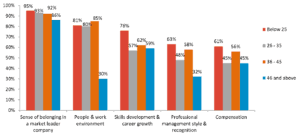
Figure 1
Preferred Type of Recognition
Data for the relationship between age and the preferred type of recognition reveals that moral recognition is more preferred by the four age groups than monetary recognition, as illustrated in Figure 2 below. Each age group, however, prefers different ways of moral recognition. The ‘Below 25’ age group prefers, both, a ‘thank you card’ and ‘personal acknowledgement’; the ’26-35’ age group prefers a ‘thank you card’; the ’36-45’ age group prefers ‘public acknowledgement’; and the ’46 and above’ age group prefers both types of acknowledgement – public and personal.
(Preferred Type of Recognition [By Age Group])
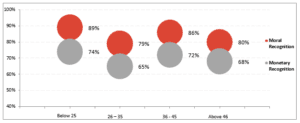
Figure 2
When investigating the relationship between gender and the type of recognition preferred the most, it is found that, both, males and females generally prefer moral recognition. More precisely, a higher percentage of, both, males and females report that they prefer the 3 types of moral recognition – collectively– over monetary recognition. Nevertheless, findings reveal that a higher percentage of male respondents prefer monetary recognition compared to female respondents- as illustrated in Figure 3 below.
(Preferred Type of Recognition [ By Gender])
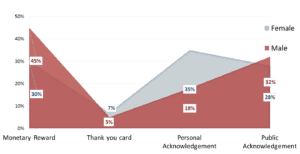
Figure 3
As for the relationship between job tenure and the preferred recognition type, data findings reveal that moral recognition is preferred by respondents who have up to 10 years of work experience; yet, for employees with more than 10 years of experience, monetary recognition is favored. This is shown in Figure 4 below.
(Preferred Type of Recognition [ By Years of Experience])
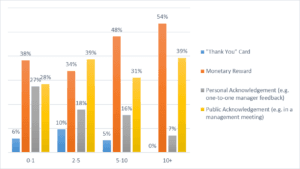
Figure 4
Aspects of Job Liked the Most
With regards to the aspects of the job liked the most, ‘Dynamic and Challenging Work’ has received the highest response rate by, both, males and females, followed by ‘Accountability and Making Decisions’. In the third place comes ‘Details & Quality’ for males and ‘Details & Quality’ and ‘Innovation’– sharing the same position- for females. ‘Motivating and Coaching Employees’ comes in the last place for, both, males and females – as illustrated in Figure 5.
Aspects of Job Liked the Most [ By Gender]
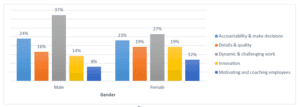
Figure 5
Recommendations & Suggestions
Based on these findings, the following points are accentuated as recommendations to be considered for implementation in similar cases.
In general, a corporation should capitalize on and utilize its employees’ sense of belonging, and their positive perception of the organization’s culture – which is reflected in the ‘People and Work Environment’ dimension – for the sake of their retention and reduced turnover. Both are also important keys to employees’ engagement, increased productivity, and improved performance. Having said that, the following suggestions are made:
The perception employees have for the company as a market leader company should be strengthened, backed, and sustained by an Employment Branding project/initiative. This shall shed the light on its position, both, in the market and in the eyes of its employees. Two main channels of communication can serve to do this: The Employment Fairs and the Social Networks such as LinkedIn. The corporation should be promoted as a talent magnet and a top-notch employer that attracts and hires the best talent and exceptional calibers. This, in fact, requires to, primarily, revisit its talent management strategies and employment promotion techniques.
Employees at all levels should be constantly guided by an inspirational mission that emphasizes the corporation’s leading position in the market and highlights the significance of maintaining this position. This would help create and/or strengthen employees’ emotional attachment to the organization.
Establishing & maintaining an effective two-way communication would also strengthen the employees’ sense of belonging as they would feel that their voices are heard and opinions are valued. Formal channels of communication that would help to achieve this (e.g. in meetings, closed social media groups, etc..) should be encouraged. This includes encouraging feedback from employees, as well as being transparent and prompt in providing feedback – whether about employees’ performance or the overall organizational performance.
There should be synchronization and harmony among the different levels and aspects of the organization’s culture. In other words, the company should ensure that the espoused values are deeply embedded and reflected in the organization’s vision, goals, strategies, and policies; as well as in the organization’s structures and business processes. Any incongruence could back fire, resulting in employees’ demotivation or mistrust.
It is also crucial to ensure that the systems, structures, procedures, and policies in place do not create divisiveness, gaps, or barriers between employees across the various departments (horizontally) or between the different levels of the hierarchy (vertically). There should be a deliberate approach to creating and facilitating synergistic teamwork and team bonding (group activities after or outside the normal working hours).
Helping employees create work-life balance is critical to creating and maintaining the sense of belonging they have towards the organization. This should be reflected in, both, the formal policies and the interpersonal interactions (especially between the management and employees).
On another note, empowering employees is crucial for creating and maintaining job satisfaction for employees of both gender. As the data findings reveal, employees report that the ‘Dynamic and Challenging Work’ is the most liked aspect of their job. It is, therefore, critical to capitalize on this through providing them with high degree of autonomy and self-determination in their scope of work; which will enable them to experience the dynamic and challenging dimensions of their jobs. That is especially important as empowerment entails a high degree of accountability and decision-making authority which are ranked, collectively, as the second aspect most liked by employees in their job.
Nevertheless, empowering employees would not be as effective if not preceded or supported by robust training and development programs that prepare employees for handling more responsibilities. Speaking of this, more emphasis should be placed on employees’ skills’ development and growth; where some interventions comprise:
Developing employees’ awareness of the significance of the training and development programs. Linking the expected advantages or outcomes of such programs to their own career and personal benefits and goals is an important step.
Assessing employees’ strengths and areas of development; which is critical to identifying the training needs effectively and accurately, and thus facilitating the process of getting employees committed to attending and benefiting from this training program.
Getting employees involvement in identifying their training needs and in setting the training agenda. This would help achieve the aforementioned benefit and overcome any resistance or lack of motivation.
Helping employees see how the training and development programs provided would benefit them on the long-term and not only on the short-term. This would act as an incentive for them to attend or even proactively ask for such programs. Such programs (or at least some of them) should be designed in a way that would help them advance in their own career and personal lives and not only within their current organization’s boundaries.
With regards to the type of recognition to be provided by an organization’s management, emphasis should be placed on non-monetary/non-financial rewards as much as monetary/financial rewards. Companies should not undermine the significance and value of providing acknowledgment and praise to their employees as a way for positive reinforcement. The type of non-monetary recognition, however, should be tailored to each and every employee based on the ‘gender’, ‘age group’, and ‘years of experience’ dimensions (as elaborated on in the previous section).
Nonetheless, the value placed by some employees on receiving monetary rewards as a way for recognizing their effort should not be overlooked. As the data findings previously presented suggest, male employees place more value on monetary recognition compared to their female counterparts, and employees with more than ten years of experience favor monetary rewards to non-monetary recognition.
Conclusion
This paper provides some insights that are likely to be useful for corporations of similar size and scope of operations. The implications deducted from the research findings lay the ground for determining the talent attraction factors for employees in various age groups and with different years of experience. These can be either entrepreneurial factors encompassing the aspects of ‘personal growth’ and ‘recognition and reward’; or intra-preneurial factors comprising the corporate brand image and position in the market as well as the corporate culture embodied in the company’s work environment. Further research into these relationships would, thus, prove useful as the relevant findings could be an invaluable guide for the talent management strategies of corporations.
More blogs to read

Digital transformation
Unleashing the Power of Digital Transformation: ASSESS’s Organizational Assessment Approach
ASSESS’s digital transformation assessment provides a comprehensive roadmap for digital transformation, focusing on digital readiness and digital maturity.
Continue reading

Ability assessment
Unlocking Talent Potential with ASSESS Focus: A Revolutionary Cognitive Ability Tool
ASSESS Focus, a cognitive ability assessment tool, designed to empower recruiters and HR professionals with meaningful insights into candidates’ ability.
Continue reading

Personality assessment
Exploring the 16 Personalities: A Guide to Understanding Yourself and Others
The MBTI sorts personality into 16 types, each represented by a unique four-letter code.
Continue reading

Personality assessment
Understanding the Big Five Personality Traits and Their Impact on Success
The Big Five—Openness, Conscientiousness, Extraversion, Agreeableness, and Neuroticism—capture the core dimensions of personality.
Continue reading

Sales assessment
Building Success: Essential Sales Competencies for High-Performing Teams
Sales competencies—core skills, behaviors, and attributes that influence sales performance—are critical for developing, and retaining top-performing salespeople
Continue reading

Sales assessment
Unlocking Sales Potential: How Assessments Drive Recruitment and Performance
Skills like communication, persuasion, and resilience are vital, but they’re not always easy to gauge in an interview.
Continue reading

Sales assessment
Enhancing Recruitment and Development with Sales Assessments
A sales assessment is a psychometric tool designed to evaluate traits, competencies, motivators, and cognitive abilities relevant to sales roles.
Continue reading

Assessment center
Types of Assessment Center Exercises
This post provides a list of potential assessment center exercises that could be used in talent selection or development.
Continue reading

Assessment center
Designing an Effective Assessment Center
Assessment Centers offer a structured, immersive approach to evaluate candidates' skills, behaviors, and potential, providing a rich basis for decision-making.
Continue reading

Leadership
What is Leadership Development Assessment?
Leadership assessment for development focuses on identifying a leader’s strengths, gaps, and growth potential to guide targeted development efforts.
Continue reading

Career orientation
Most Relevant Career Orientation Assessment Frameworks
Career orientation assessments provide valuable insights into an individual’s strengths, preferences, and interests.
Continue reading

Employee engagement
Top Five Employee Engagement Drivers: Backed by Research
Employee engagement is critical for organizational success, impacting productivity, retention, and overall company performance.
Continue reading

Assessment
Talent Assessment Using ISO 10667: Ensuring Quality and Consistency
To standardize talent assesment practices and ensure their quality, ISO 10667 provides a comprehensive framework.
Continue reading

Talent acquisition
How to Select the Right Assessment Tools for Your Organization
Choosing the right assessment tools is crucial for organizations aiming to make informed decisions about recruitment, employee development, and talent selection
Continue reading

Recruitment
Hiring Millennials: How Talent Assessments Help Build an Independent and Innovative Workforce
As millennials continue to make up a larger share of the workforce, companies must adapt their hiring strategies to attract and retain this dynamic generation.
Continue reading

Competency
ASSESS Grammar Test: Boosting Workplace Communication Skills
Proper grammar is essential for conveying messages accurately, whether in emails, reports, or client interactions.
Continue reading

Competency
Manages Ambiguity: Navigating Uncertainty with Confidence
In today’s dynamic business environment, leaders often face situations where information is incomplete, outcomes are uncertain, or events unfold unpredictably.
Continue reading

Competency
Decision Quality: A Cornerstone of Effective Leadership
Decision quality represents a leader’s ability to make well-considered, timely, and effective decisions, even in complex or ambiguous situations.
Continue reading

Competency
Instills Trust: A Key Leadership Competency
Trust is a cornerstone of effective leadership and organizational culture.
Continue reading

psychometrics
Can We Assess Toxic Workplace Traits?
As we become more attuned to the detrimental effects of toxic styles, the importance of assessing behaviors that contribute to toxicity has become critical.
Continue reading

Ability assessment
The Power of Cognitive Ability Tests in Talent Management
Cognitive ability tests are effective tools for evaluating potential to excel in roles that demand analytical thinking, quick learning, and problem-solving.
Continue reading

360 degree feedback
360-Degree Feedback: Benefits, Challenges, and Best Practices
360-degree feedback has become a popular tool in talent development, particularly for enhancing leadership skills and fostering continuous improvement.
Continue reading

Psychometrics
How to Use Personality Assessments to Improve Team Dynamics
Effective teamwork is essential for organizational success, and one of the best ways to enhance team dynamics is through personality assessments.
Continue reading

Psychometrics
The Science Behind Psychometric Testing: How Assessments Drive Better Hiring Decisions
The Science Behind Psychometric Testing: How do assessments drive better results using scientific methods, such as validity and reliability testing.
Continue reading

Organizational surveys
Measuring Organizational Health: Key Metrics and Why It Matters
Discover how measuring organizational health through key metrics like engagement, leadership, and culture alignment can boost long-term success and adaptability
Continue reading

Assessment tools
Assess International vs. AssessFirst: A Comparative Overview
Assess International vs. AssessFirst: A Comparative Overview
Continue reading

Personality assessment
The 16 MBTI Personality Types: A Detailed Overview
MBTI categorizes people into 16 distinct personality types based on four key dichotomies. They shape how people interact with the world.
Continue reading

Cognitive ability
Understanding Cognitive Ability Assessments: Unlocking Mental Potential
Cognitive ability assessments are tools that measure the intellectual capacity, such as reasoning, attention, memory, and learning.
Continue reading

Coaching
The Role of Assessment in Coaching: Unlocking Potential through Insight
One of the primary benefits of using assessments in coaching is that they promote self-awareness. Assessments provide objective, data-driven insights
Continue reading

Personality assessment
Unlocking Self-Awareness with the Enneagram Test: A Path to Personal Growth and Understanding
Explore the Enneagram test, a powerful tool for self-awareness, personal growth, and improving relationships through understanding motivators and behaviors.
Continue reading

Personality assessment
Understanding the DISC Personality Assessment: A Pathway to Better Communication and Teamwork
Discover how the DISC personality assessment improves communication, enhances teamwork, and strengthens relationships by understanding behavior styles.
Continue reading

Personality assessment
The Importance and Value of the MBTI Assessment: A Tool for Self-Awareness and Team Dynamics
Discover the importance and value of the MBTI assessment in fostering self-awareness, improving communication, and enhancing team dynamics.
Continue reading

Talent Management
Understanding Generation Z: Engaging the Restless Workforce
Generation Z, born roughly between 1997 and 2012, is entering the workforce with a unique set of expectations and challenges. Companies seeking to engage and retain Gen Z talent need to understand what drives this generation.
Continue reading

Talent management
Why do employees stay at your company
Talent Management, embodied in attracting, retaining, and motivating superior employees is a critical issue as it is amongst the top concerns for modern cor ...
Continue reading

Career
Unlocking Career Success with ASSESS Career Orientation: A Comprehensive Approach
Choosing the right career is one of the most significant decisions you will make in life. It shapes not only your professional trajectory but also impacts y ...
Continue reading

Assessment
What is an Assessment Center?
The term assessment center has been widely used in the fields of industrial psychology and human resources management for more than 50 years ...
Continue reading

Assessment
Personality Psychology & Job Performance
Personality psychology is a branch of psychology that focuses on defining and explaining personality as well as identifying individual differences between p ...
Continue reading

Leadership
Chameleon Leader: Situational leadership model
Leadership theory has been studied for many years. There are many different theories that define leadership from different perspectives, all expressing thei ...
Continue reading

Career
Understanding your core values as a human
You place great emphasis on understanding the values that shape your thoughts and lifestyle. Your quest for finding meaning in life drives you to seek align ...
Continue reading

Tools
Can Values Be Measured Using Assessment Tools?
The question of whether values can be accurately measured through assessment tools has been a topic of debate in psychological, organizational, and educatio ...
Continue reading

Phsycometrics
Understanding the different types of psychometric testing categories
Psychometric testing has become a valuable tool in various fields, including recruitment, personal development, and career orientation
Continue reading

Talent
Talent abiligy post pandemic
While many businesses have withstood the economic shock brought on by Covid19, nonetheless making amendments within the organization’s practices and strateg ...
Continue reading

Products
The role of ASSESS OCM in recruitment and professional development
In today’s fast-evolving workplace, organizations are continuously seeking ways to optimize their talent management processes. One of the most effective too ...
Continue reading

Psychometric, Assessment
How to Prepare for a Psychometric Assessment
Psychometric assessments are becoming a common part of the recruitment process and personal development programs. These tests measure a variety of cognitive ...
Continue reading

Psychometric, Assessment
What is a Psychometric Assessment Test?
Psychometric assessment tests have become an essential tool for businesses, educational institutions, and individuals seeking to understand personality trai ...
Continue reading
Individual Development
